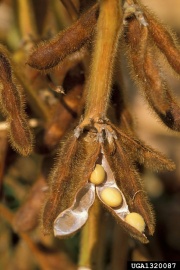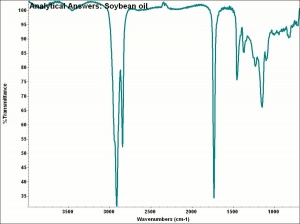Difference between revisions of "Soybean oil"
| Line 6: | Line 6: | ||
== Synonyms and Related Terms == | == Synonyms and Related Terms == | ||
| − | ''Soja hispida; Soja japonica; Phaseolus hispida''; aceite de soja (Esp.); huile de soja (Fr.); olio di soia (It); bean oil; Chinese bean oil; soy oil; soya bean oil; soja bean oil; Fidelis Artist's Oil Colors [Hunt Manufacturing Co., Philadelphia PA] | + | ''Glycine max, Soja hispida; Soja japonica; Phaseolus hispida''; aceite de soja (Esp.); huile de soja (Fr.); olio di soia (It); bean oil; Chinese bean oil; soy oil; soya bean oil; soja bean oil; Fidelis Artist's Oil Colors [Hunt Manufacturing Co., Philadelphia PA] |
[[[SliderGallery rightalign|aaiSOYOIL.jpg~FTIR]]] | [[[SliderGallery rightalign|aaiSOYOIL.jpg~FTIR]]] | ||
Revision as of 12:38, 18 June 2020
Description
A pale yellow, semidrying oil obtained from the beans of the soya plants, Glycine max; Soja hispida, Soja japonica, or Phaseolus hispida. Originally native to Asia, the soybean is now cultivated throughout the world. Soybean oil contains the following fatty acids: palmitic (12-14%), oleic (25-26%), linoleic (53-57%), stearic (2%) and linolenic (3-8%). The oil dries slowly to form a soft, clear film. The film, however, remains tacky and darkens with age. Soybean oil has been used as an Additive in alkyd-based industrial paints. It was also used in Fidelis Artist's Oil Colors. Commercially, soybean oil is used in margarine, shortening, vegetarian food products, paints, adhesives, fertilizers, Linoleum, cloth sizing, insect sprays and fire extinguishers.
Synonyms and Related Terms
Glycine max, Soja hispida; Soja japonica; Phaseolus hispida; aceite de soja (Esp.); huile de soja (Fr.); olio di soia (It); bean oil; Chinese bean oil; soy oil; soya bean oil; soja bean oil; Fidelis Artist's Oil Colors [Hunt Manufacturing Co., Philadelphia PA]
Physical and Chemical Properties
- Soybean oil is soluble in ethanol, ether, chloroform, carbon disulfide.
- Saponification number = 190-200; Iodine number = 121-139; Acid number = 0-5.
- Melting Point = 22-31
- Density = 0.924-0.926
- Refractive Index = 1.4760-1.4775
Sources Checked for Data in Record
- Thomas J.S. Learner, Analysis of Modern Paints, Getty Conservation Institute, Los Angeles, 2004 Comment: source for some fatty acid consentrations
- G.S.Brady, Materials Handbook, McGraw-Hill Book Co., New York, 1971 Comment: p/ 746
- The Merck Index, Martha Windholz (ed.), Merck Research Labs, Rahway NJ, 10th edition, 1983 Comment: entry 8879
- Encyclopedia Britannica, http://www.britannica.com Comment: "soybean." Encyclopædia Britannica Premium Service 12 Apr. 2005 .
- R. J. Gettens, G.L. Stout, Painting Materials, A Short Encyclopaedia, Dover Publications, New York, 1966 Comment: source for some fatty acid concentrations
- Ralph Mayer, A Dictionary of Art Terms and Techniques, Harper and Row Publishers, New York, 1969 (also 1945 printing)
- Reed Kay, The Painter's Guide To Studio Methods and Materials, Prentice-Hall, Inc., Englewood Cliffs, NJ, 1983
- Kurt Wehlte, The Materials and Techniques of Painting, Van Nostrand Reinhold Co., New York, 1975 Comment: p. 387
- M. Doerner, The Materials of the Artist, Harcourt, Brace & Co., 1934
- Richard S. Lewis, Hawley's Condensed Chemical Dictionary, Van Nostrand Reinhold, New York, 10th ed., 1993
- Random House, Webster's Encyclopedic Unabridged Dictionary of the English Language, Grammercy Book, New York, 1997
- The American Heritage Dictionary or Encarta, via Microsoft Bookshelf 98, Microsoft Corp., 1998
- CRC Handbook of Chemistry and Physics, Robert Weast (ed.), CRC Press, Boca Raton, Florida, v. 61, 1980 Comment: melting point = -16.0, density=0.927, ref. index = 1.4729, iodine value=130, saponification value = 190.6; palmitic acid (9.8%), stearic acid (2.4%), oleic acid (28.9%), linoleic acid (50.7%); linolenic acid (6.5%)
- Art and Architecture Thesaurus Online, http://www.getty.edu/research/tools/vocabulary/aat/, J. Paul Getty Trust, Los Angeles, 2000

